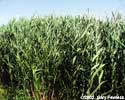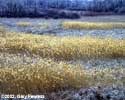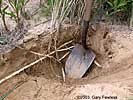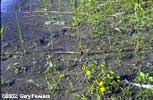
Wetland Plants of Wisconsin
| Phragmites australis (Cav.)
Trin. ex Steud. common reed Family: Poaceae invasive species |
||||||||||||||||
|
||||||||||||||||
|
Phragmites australis (Cav.) Trin. ex Steud, (also referred to as Phragmites communis Trin. in some earlier publications) is a tall and robust grass with culms up to 3-4 meters tall, broad leaves and large, showy inflorescences. Phragmites does not seed as heavily into new sites as might be supposed from the dense populations, but seedlings that do become established form very aggressive clones which grow vegetatively to cover large areas. Clones of Phragmites can be extremely long-lived and they commonly expand by vigorous lateral growth of large rhizomes. Much less commonly, during periods of falling water level, they may also send out extremely fast-growing stolons that can grow and extend the colony up to 50 feet across the newly exposed mud in a single growing season. Phragmites australis is a widespread and aggressive invasive species. It appears to be nearly global in distribution in freshwater wetlands, it is found throughout the continental U.S.A. and is widely distributed in Wisconsin, although it appears to be most common in the southern part of the state, along the Great Lakes, and in and around cities. It quickly colonizes roadside ditches and heavily disturbed sites and more slowly invades our native, sunny wetlands of moist soil to shallow water. In a few locations it has also become well established in deeper water sites. It appears to be steadily increasing in Wisconsin and during the recent low water levels in Lake Michigan (1999-2004) it has dramatically expanded into the newly exposed lakebed, forming large clones which exclude virtually all other plants. As in all invasive plant control problems, the best return for limited resources rests in prioritization of sites, monitoring and early discovery and removal, and vigilance thereafter. Because Phragmites does not usually produce large numbers of new seedlings, one of the most effective means for control is to monitor susceptible areas and destroy the new plants before they can expand vegetatively. This is especially true in cases where wetlands have been disturbed, or in recently created or restored wetlands. Once an established wetland vegetation is in place, the incidence of colonization by Phragmites is much reduced and expansion of the clones is much slower. Application of herbicides can be effective in killing established populations of Phragmites, but may also kill other, more desirable plants in the area and if the site is not monitored thereafter, any surviving plants can quickly reoccupy the area. Expectations are low for restoring wetlands already colonized by large, long-established populations of Phragmites in disturbed landscapes. |
|








